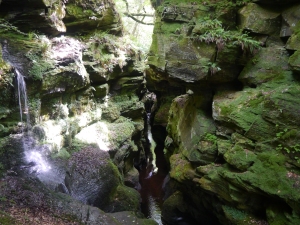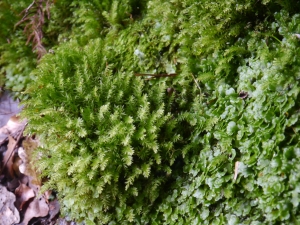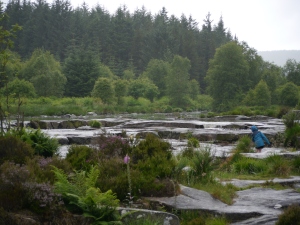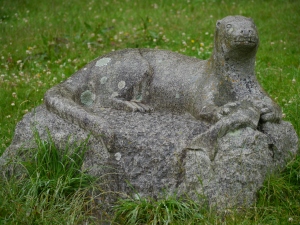Dappled sunlight far above; below black waters gurgled. I was encased in sandstone, thick with moss, ferns gripping resolutely to every crevice.
We had found ourselves at Crichope Linn, after a short walk through woodlands. It was the sort of walk where you wished you had insisted that shorts and sandals may not be ideal for young explorers. One of those where brambles and wild roses stretch across the narrow path; where, though trampled rarely it seemed, the ground remained soft in all seasons, churned in places. It is the type of place you keep an eye open for the flash of a kingfisher above the burbling burn, but never catch one. Above, something shrieked.
At the Linn the water sprites come out to play, in dark pools, under fallen trees, and in those caverns where the light from above catches some of the tumbling waters, but not all. 30m deep, if you take the path to the oak and beech trees above you might never know what lies beneath. But over the centuries plenty did.
Walter Scott put John Balfour there in Old Mortality. Of the etchings scratched into the soft sandstone one may have come from Burns. Covenanters hid in a cave in the Killing Times. The Elf’s Kirk has been broken up for building stone. It is a place of magic. And the water sprites play on.
Just down the road we stopped at another of Burns’ haunts, the much over-looked Ellisland Farm, where he tried in vain to plough the rubble, to gather apples, and where his Bonnie Jean brought the children of the marriage to nine, and more beyond. We wandered the river walk, where the words of Tam O’Shanter first took shape.
Ellisland is rammed full of memorabilia from the days of the bard; days brought to life by our resident expert. A herd of cows came over, much to the delight of the children. But it was Burns and his life that held them more.
We touched briefly on more of the Burns trail in Dumfries, before chancing upon our third wee gem on the homeward leg, the long way round. The Raiders Road is open through the summer; 10 mile or so of dirt track and hard-core, through the forest, along the banks of the Black Water of the Dee. There is an Otter Pond, something never to be resisted.
This is a very special place and those good folk of the Forestry Commission, busy harvesting the slopes around, have laid on facilities, from parking to picnics, barbecues to washrooms.
And out on the black waters we watched and we waited. But the only movement was of the ever-increasing circles of the raindrops and the birling of the midges, the occasional fish rising for supper. It is though a place for children to play, rain or no rain. For the waters are shallow, tumbling over flat rocks, layered between the banks, upstream and down.
But the only otter was cast in tablets of stone, replacing a bronze effigy nicked some years ago. It is another place of magic, though we were perhaps too early in the evening to hope that the otter just might come out to play. And so the only otter I have seen in the wild remains a memory from Jura, despite the quest continuing.
But it was a Grand Day Out, water sprites, otter strikes, and Rabbie. And they were all picked out from Peter Irvine’s Scotland The Best, though we really need to update our 1998 edition. Where next, one wonders….


















































































































Pingback: Spanning the centuries | laidbackviews